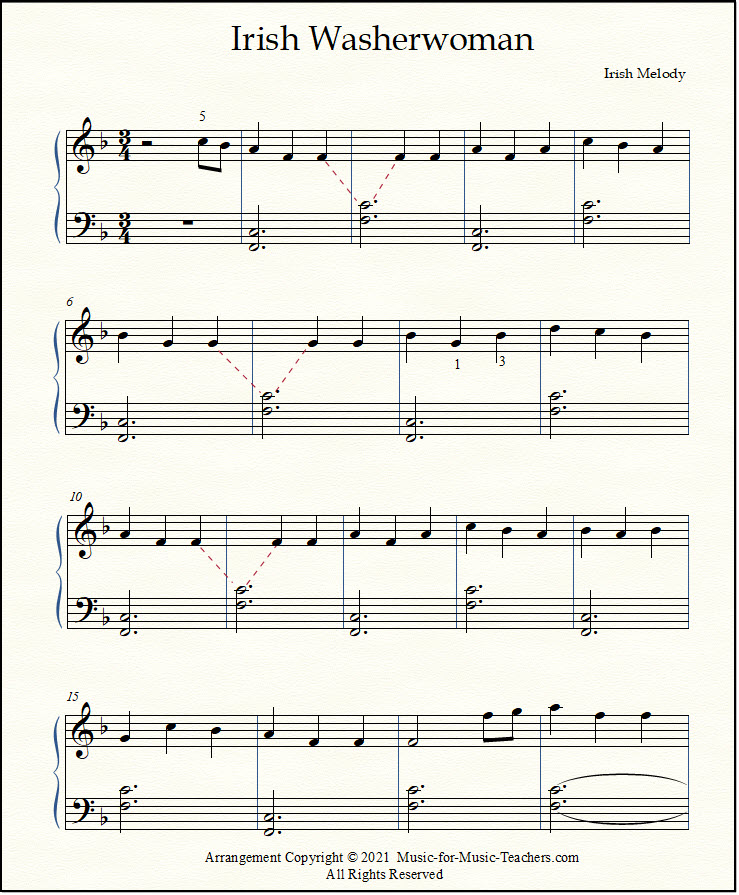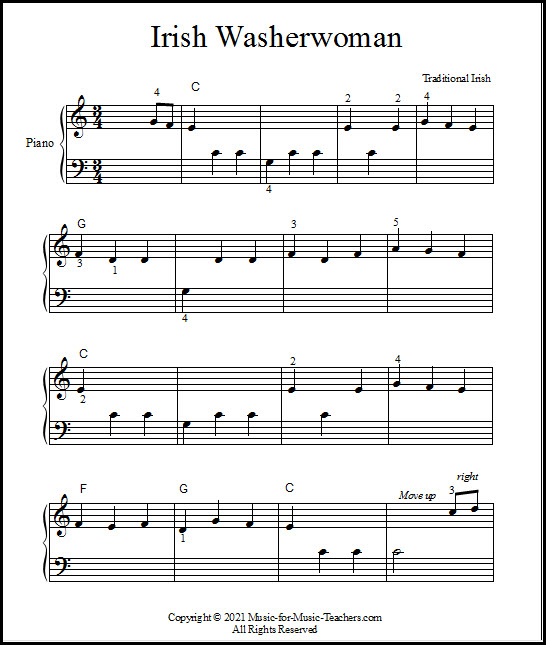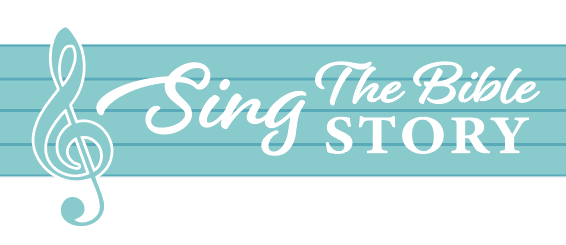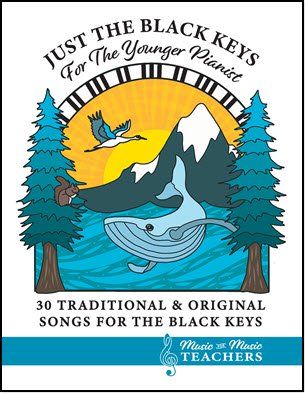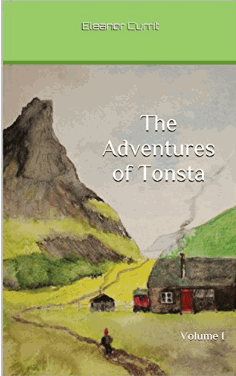Irish Washerwoman
Sheet Music
Irish Washerwoman sheet music duet and solo for piano, with a swinging left hand part that adds energy to this happy-sounding melody!
Here is the late elementary solo - look way down the page for the beginner's version, which can be a duet primo with secondo.
Please scroll down the page for the download links.
Jumping octaves
What is that left hand doing? Up and down chords, moving a whole octave? Yikes!
Yes, this will take a bit of practice. And you may have to treat this arrangement as a duet between you and your student, at first. But at least it is the same chord, over and over again.
On page 2, the pattern in the left hand changes. It's not too complicated until close to the end, where the left hand breaks out of any pattern and takes real attention to detail.
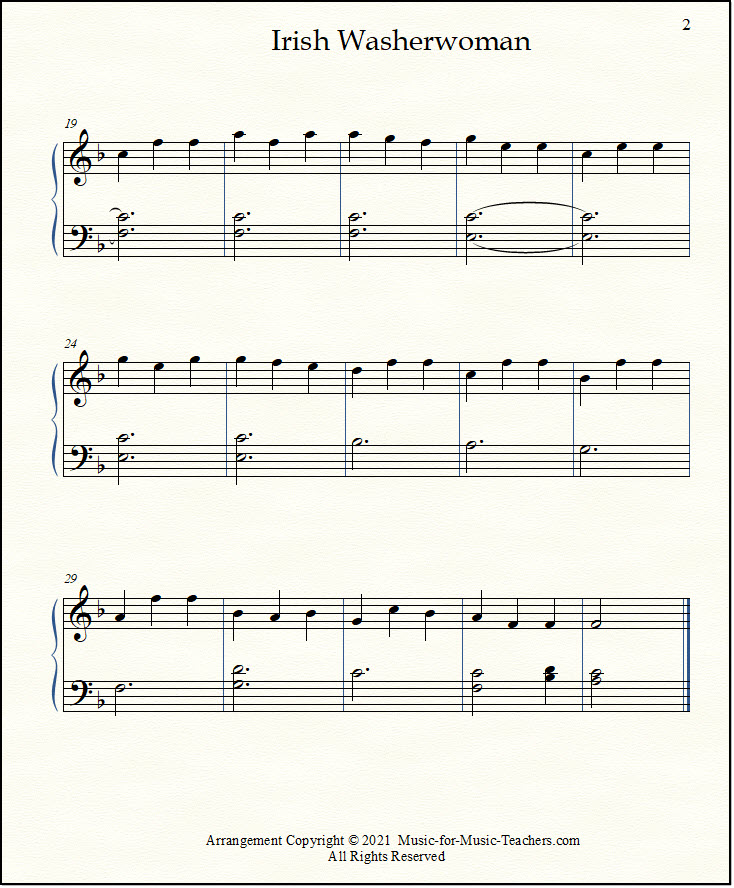
Look for melody patterns
Help your student find where there are melody fragments that seem to repeat, or at least echo, a bit of a previous melody line or phrase. These little patterns are key to memorizing, to playing with ease, and also with musicality - "pressing into" the repeated motif emphasizes its relationship to the motif that came before, and helps the music sound like a real conversation.
What about fingering?
I have placed almost NO fingering into this arrangement. You and your student should play with the right hand phrases and base your fingering on some experimentation.
There is some stretching that will need to happen - if your student doesn't SEE those places, hand her or him a colorful pen to circle the notes that require new hand positioning. (They might remember it better if they are the ones wielding the pen!)
Note recognition
If there is hesitation reading some of the high notes, get out your student's Note Reading Worksheet, and have them identify the notes, even writing tiny letter names next to the offending notes.
Use staff paper to practice note writing
The following lesson, if you see any hesitation about notes, I suggest grabbing a blank piece of staff paper, and using just the top staff line (that's all there's time for in one lesson), select a measure of two of the Irish Washerwoman to transcribe (copy) onto the staff paper. I suggest that both of you do it - divide the top staff into two halves, and say, "This is my side - that's your side. We're just going to copy these notes right here."
Sometimes you will be surprised to see how they are interpreting the notes. Bigger staff paper may help! I find that note drawing like this gives students more confidence interpreting sheet music. Then, ask them to play what they have drawn. Have the Note Reading Worksheet on hand!
A version for elementary students
Because of the high notes in part 2 of Irish Washerwoman, this isn't exactly a beginner piece! Plus, there are many skips. Page 1 is pretty easy, though.
Both hands up high
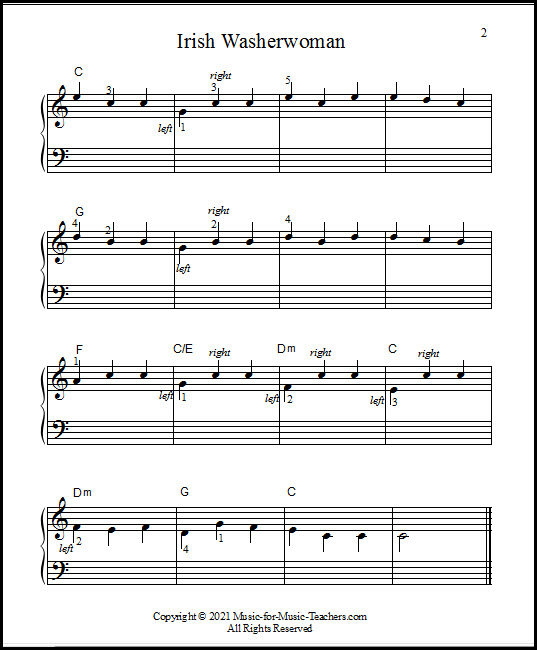
Please scroll down the page for the download links.
So left hand moves up into treble clef! This may be tricky territory for your student. A bit of lime green and red coloring may help out, initially - just like when they were beginners and circling the notes with a color helped make sense of their music!
I would ask them to draw little green circles around the left hand notes... and if it seems helpful, red loops for the right hand.
(Lime = left; red = right.)
The secondo is straight chords - with one exception
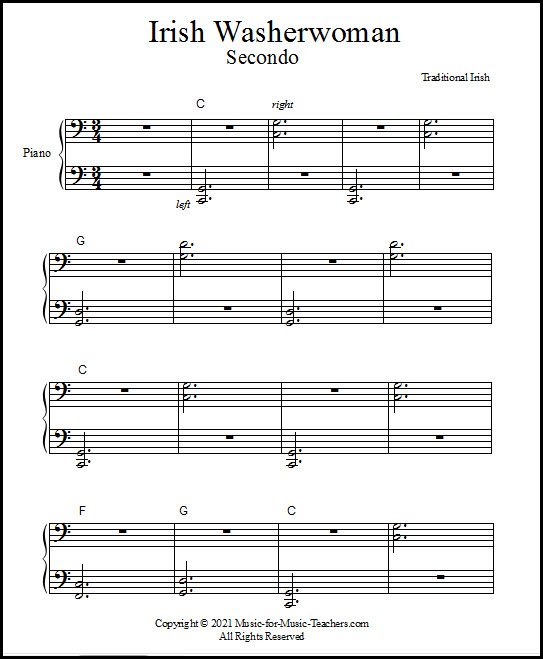
Two bass clefs! This might be another great opportunity for note-reading. Get out that handy-dandy Note Reading worksheet.
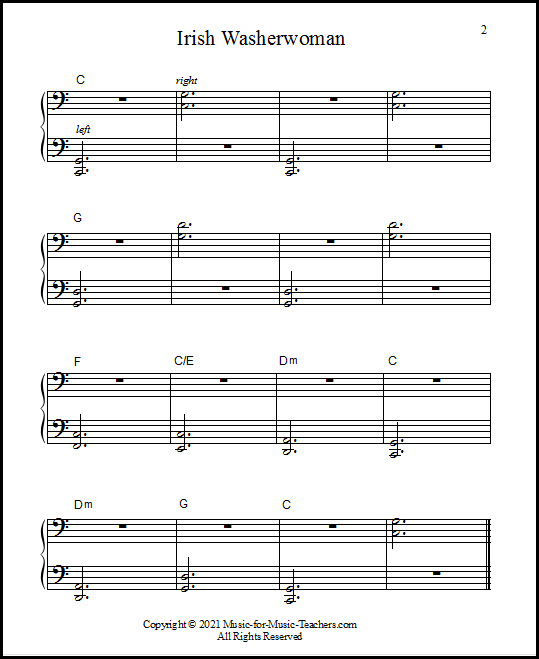
As I promised, everything in the Secondo is straight open chords - ALMOST. In the penultimate line of music, we have a wonderful opportunity for the sound of a walking bass.
Down steps the bass line, from F, to E, to D, to C. It's a satisfying sound, and your students will get it if you tell them they are playing the way a bass guitar plays!
HOWEVER... there will be one odd chord. The "slash" chord, the C over E (C/E) is likely to be a new experience for your student. Don't be in a rush! It may be that they would enjoy playing a single bass note instead of an open 5th chord... and that may foster greater understanding as well.
The link for the piano music:
Download Irish Washerwoman sheet music piano solo
The beginner solo or duet primo:
Download the shared-hands melody for beginners
Download the duet secondo part
Dianna:
Your website is a light in the darkness. THANK YOU for all you do in helping to spread the love of music. It matters!
Recent Articles
-
Favorite Christmas Songs: Duet Vocal Sheet Music
The best duet Christmas songs are those ones you knew & loved as a child! This set of 14 "a capella" carols arranged for 2 voices is just right for caroling! -
"Walking In the Air" Piano Music from The Snowman
This sparkling piano arrangement of the main musical theme from The Snowman will win your students' hearts and imaginations, too, with its soaring beauty! -
Moonlight Sonata: How to Play Beethoven's Lovely Piece
Moonlight Sonata: How to play this beautiful but difficult piece full of black keys & triplets? With larger-than-usual notes, & letters inside the note heads! -
Classical Piano Sheet Music: a Set of Introductions
Classical piano sheet music - Fun, mostly one-page intros! Bach, Beethoven, Mozart & more - see what's new! -
Singing In a Round: "Come Away" Has Six Possible Parts!
Singing in a round is a fun challenge for voice students! This pretty song, "Come Away," can be sung with as few as 2 voices, or as many as 6. Free PDFs!!
Interested in songs from the Bible for your students or church? Check out my other website, SingTheBibleStory.com!
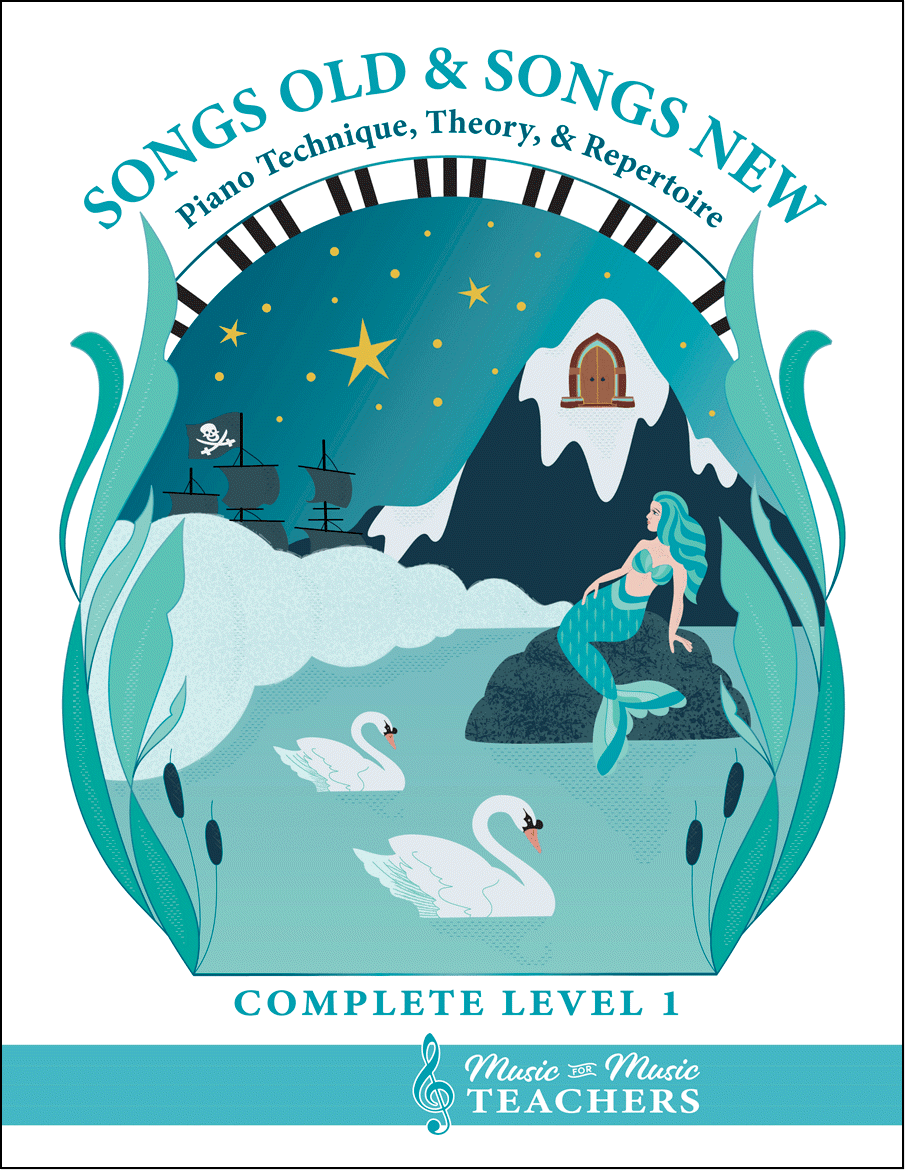
All the first-year material I give my beginner students.
Piano keyboard sheets, scales, chords, note-reading exercises, and over 256 pages of music!
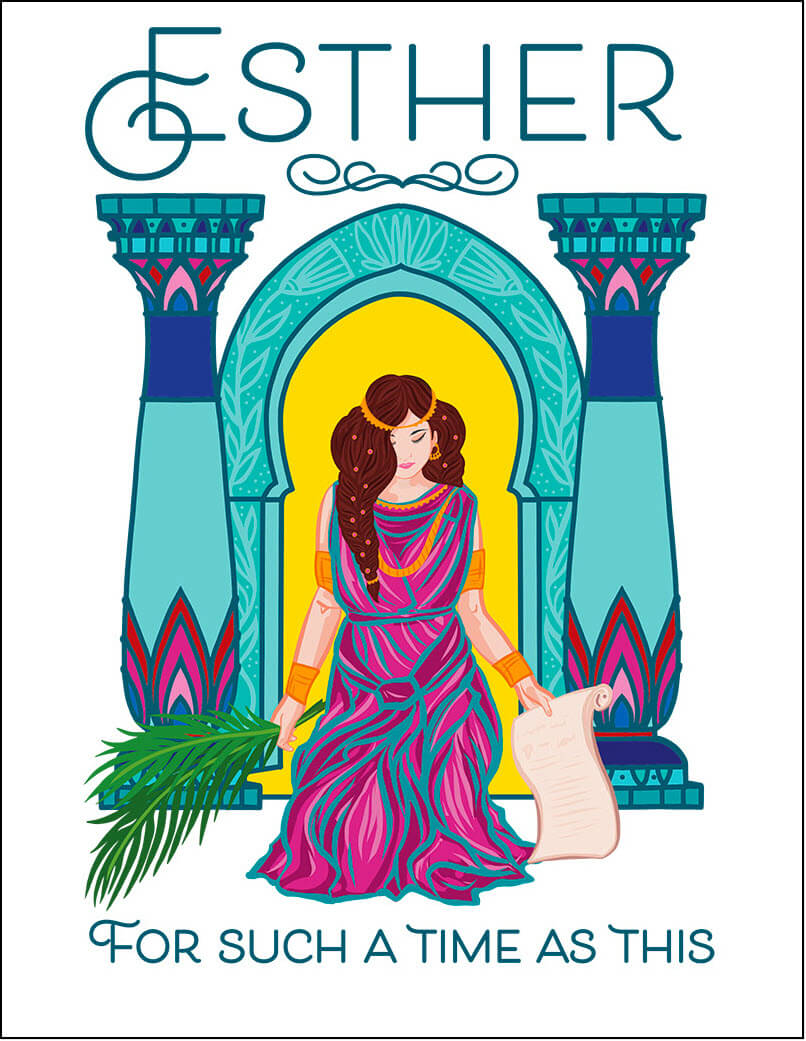
This beautiful song book for piano & voice "Esther, For Such a Time as This", available as a digital download, tells the riveting story of the time when Jews in ancient Persia faced a foe named Haman, and how a brave young queen risked her life to save her people.
A good choice for a singing story-teller, an operatic group, a short theater production, or a class of children!
This book is also available from Amazon as a paperback.
This book is available as a digital download from this site. Visit this page to see some free examples from the book.
It is also available from Amazon as a paperback!
This is the perfect easy start for little pianists.
And when they start reading white-key notes on the staff, this is a fun easy resource to say each week, "Choose a new black-key song at home this week and figure it out to show me next lesson!" They will be spending more time at the piano.
A perfect read aloud storybook
for little boys or girls.
The Adventures of Tonsta highlight the travels of a very young boy with a good heart, who goes about helping folk in trouble.
With a red cap on his head and a sack of tools slung over his shoulder, Tonsta seems to meet people in distress wherever he goes.
Lots of trolls in this book - including one who gives him a Christmas gift!
About the Author

Hi, I'm Dana! (Say that like "Anna".) I'm the owner of Music-for-Music-Teachers.com, and a newer site, SingTheBibleStory.com.
Like some of you, I've been playing the piano since early childhood, and have added a few other instruments along the way, plus an interest in arranging and composing music.
You can find out more about me and the reason for this website at my About Me page.
